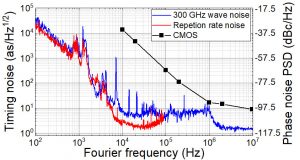State-of-the-art Millimeter-wave generation on-chip
Abstract
Attosecond-level timing noise is measured for the first time at 300 GHz for Fourier frequency > 1 kHz. A 300 GHz signal is generated by the combination of low-noise stimulated Brillouin scattering process, dissipative Kerr soliton comb, and optical-to-electrical conversion.
Background
Record data rate in wireless networks, autonomous cars, imaging of cosmic radiation, and subatomic particle physics colliders, are among the applications that will be boosted by the emergence of a new class of millimeter-wave oscillators lying between the microwaves and the infrared light (100 GHz to a few THz). This emergence relies on how efficient and performant those oscillators can be implemented, preferably in mass-production form factor. A group of researchers at IMRA America, Inc. have unlocked the limitations in terms of spectral purity that were, up until now, ruled by RF and microwave technologies. Here, a millimeter-wave at 300 GHz has been referenced to an optical signal for the first time enabling it to overcome constraints imposed by microwave references. The core of this new oscillator consists in the generation of a dissipative Kerr soliton comb that is generated from a Silicon-nitride-chip-based microresonator.
How is works and where it leads
This new concept is depicted on figure 1. Two ‘noisy’ diode lasers are spectrally purified by a fiber ring cavity through stimulated Brillouin scattering offering, when spatially overlapped, a tunable optically-carried multi-THz reference. When the two degrees of freedom of an on-chip silicon nitride 300 GHz soliton microcomb is referenced on this dual-light, the free running noise of the soliton comb is strongly reduced under the influence of optical frequency division mitigating its phase noise by a factor of N (corresponding to a divisor between the multi-THz reference and the repetition rate of the soliton comb, i-e, N = 3.6 THz / 300 GHz = 12 in the reported work). When the output of the soliton microcomb, consisting of an optical pulse train disciplined to the multi-THz reference, illuminates an ultra-fast photosensitive device the optical pulse train is converted into a 300 GHz radiation emitted in a waveguide or in free space through an antenna. This combination of optoelectronic components lead to a record spectral purity at 300 GHz with attosecond-level noise floor with Fourier frequency as low as 1 kHz (See Figure 2).
 This level of noise in this frequency range has never been explored before and original methods to characterize this unprecedented noise level have also been reported by IMRA’s researchers in this work. It is worthwhile to notice that, in terms of noise performance, this millimeter-wave oscillator far outstrips by orders of magnitude its counterpart in the microwave domain using CMOS technology.
This level of noise in this frequency range has never been explored before and original methods to characterize this unprecedented noise level have also been reported by IMRA’s researchers in this work. It is worthwhile to notice that, in terms of noise performance, this millimeter-wave oscillator far outstrips by orders of magnitude its counterpart in the microwave domain using CMOS technology.
This highly compact (potentially chip-scale with further efforts) 300 GHz millimeter-wave oscillator can impact many civilian applications such as future deployment of 5G and 6G wireless networks, vehicular communications and fundamental science.
Further reading
T. Tetsumoto et al. “Optically referenced 300 GHz millimeter-wave oscillator”, Nature Photonics 2021
https://www.nature.com/articles/s41566-021-00790-2



